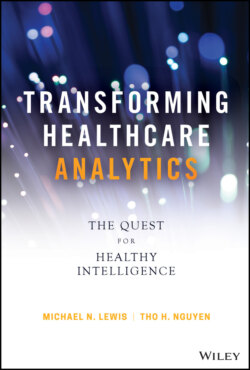Читать книгу Transforming Healthcare Analytics - Michael N. Lewis - Страница 21
HEALTHCARE DATA
ОглавлениеData exists in every organization, whether it is in finance, manufacturing, retail, or government and it is no different in healthcare. Data is even more critical in healthcare since data is turned into information that clinicians rely on to make informed decisions that can mean life or death. Because we are collecting many more data (from telehealth, images, mobile devices, sensors, etc.) than ever before and the speed at which we collect the data has significantly increased, data volumes have grown exponentially. In particular, healthcare providers have at least doubled their data volumes in less than 24 months, which is beyond what Moore's law (that the rate of change doubles in 24 months) had predicted over 50 years ago. With the pace of change accelerating faster than ever, healthcare providers are looking for the latest, proven innovation in technologies to better manage all of the data and apply analytics to help transform every challenge into opportunities to impact positively the patient's experience.
The data explosion in healthcare exacerbates the challenges that healthcare organizations are facing. IDC, a research firm, conducted a study in April 2014 and reported that healthcare data grows to 2,314 exabytes or 2.314 zettabytes (which has 21 zeros) in 2020. To give you a sense of how much data this is, the report illustrated an analogy to where all of the patient data stored in tablet computers would stack up to 82,000 miles high. This is equivalent to a third of the way to the moon. Data in healthcare is expected to continue to increase by 48% annually and much of the data will be in an unstructured format where it cannot be stored in columns and rows. Traditionally, clinicians have documented clinical findings and facts on paper, and even now tend to capture data in whatever method is most convenient for them, often with little regard for how this data is eventually captured, integrated, and analyzed. Electronic medical record (EMR) systems have attempted to standardize the data capture process and documentation of the patient data but it has not been able to accommodate the cumbersome data capture process.
The healthcare sector and its data are unique compared to other industries. Compared to other industries, data in healthcare is more difficult to deal with (see Figure 1.4) because it is:
Multifaceted and resides in many systems (silos)
Often unstructured
Under strict regulations
The next sections will go into more depth on each of these issues.
Figure 1.4 Uniqueness of Healthcare Data
Source: Author.
